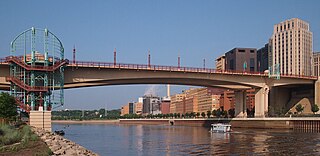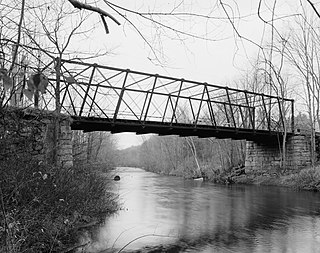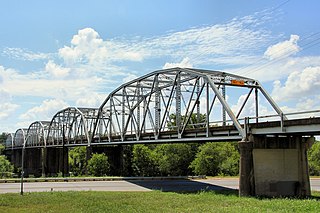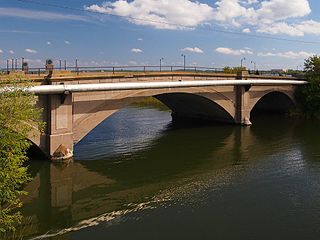
The Stillwater Bridge is a vertical-lift bridge crossing the St. Croix River between Stillwater, Minnesota, and Houlton, Wisconsin. It formerly connected Minnesota State Highway 36 and Wisconsin Highway 64. Around 18,000 vehicles crossed the bridge daily. The new St. Croix Crossing bridge crossing the St. Croix river valley to the south of Stillwater replaced its purpose, having opened to highway traffic on August 2, 2017, leaving the Stillwater Lift Bridge to be preserved and to be converted to bicycle/pedestrian use.

The Smith Avenue High Bridge or the High Bridge is an inverted arch bridge that carries Minnesota State Highway 149 and Smith Avenue over the Mississippi River in Saint Paul, Minnesota, United States. It was built and opened in 1987 at a cost of $20 million. The bridge carries two lanes of street traffic over the river and is the highest bridge in St. Paul, with a deck height of 160 ft (49 m) and a clearance below of 149 ft (45 m).

The Wabasha Street Bridge is a segmental bridge that spans the Mississippi River in downtown Saint Paul, Minnesota, United States. It was named Wabasha Street Freedom Bridge in 2002, to commemorate the first anniversary of the September 11 attacks. It actually consists of two separate bridges, one for northbound and one for southbound traffic. The use of a concrete segmental box girder bridge provided a construction advantage because no falsework needed to be built beneath the bridge.

Minnesota State Highway 101 is a state highway in the U.S. state of Minnesota. The present day route currently has two separate segments. The roadway was a continuous route until 1988.

The Lamar Boulevard Bridge is a historic arch bridge carrying Texas State Highway Loop 343 over Lady Bird Lake in downtown Austin, Texas, United States. The bridge features six open-spandrel concrete arches spanning 659 feet (201 m) and carries tens of thousands of vehicles daily across the lake. Completed in 1942, the Lamar Boulevard Bridge was the second permanent bridge to cross the Colorado River, and one of the last Art Deco-style open-spandrel concrete arch bridges built in Texas. The bridge was named an Austin Landmark in 1993 and added to the National Register of Historic Places in 1994.

U.S. Highway 169 (U.S. 169) is a major north–south highway in the U.S. state of Minnesota, connecting the Minnesota River valley with the Twin Cities and the Iron Range. Much of the route is built to expressway or freeway standards.

Kern Bridge or Yaeger Bridge crossed the Le Sueur River in Blue Earth County in the U.S. state of Minnesota. It was built in 1873 using a bowstring through truss design by the Wrought Iron Bridge Company. It was 183.5 feet (56 m) long and carried a local road. It was listed on the National Register of Historic Places in 1980 as Minnesota's only bowstring arch truss bridge and oldest road bridge still in use. However, it was closed to vehicle traffic in 1991.
The Shakopee Bridge is a four-lane vehicular bridge crossing the Minnesota River between Chanhassen and downtown Shakopee. The bridge carries Scott County Road 101 (CR 101) traffic across the bridge. This bridge opened in 1993, one city block downstream from a two-lane bridge it replaced.

The Harris Street Bridge is a historic truss bridge that spans the Taunton River off Dean Street in Taunton, Massachusetts. Built in 1887, it is the oldest surviving bridge in the city, and was built as part of one of the city's earliest public works projects after incorporation as a city. It was added to the National Register of Historic Places in 1984. It is closed to traffic, and is in disrepair.

The Ponakin Bridge is a historic Post truss bridge spanning the Nashua River in northern Lancaster, Massachusetts. The bridge was built in 1871, and originally carried the main north–south road, which was bypassed by the construction of Massachusetts Route 70. It is now unsafe and closed even to pedestrians. The bridge, with a design once common but now extremely rare, was listed on the National Register of Historic Places in 1979.

The 19th Street Bridge is a two-span through Pratt truss road bridge in Denver, Colorado, over the South Platte River, now used for pedestrians. It was built in 1888 to replace a wooden structure and carried automobile traffic until 1986. The bridge is listed on the National Register of Historic Places.

The Gateway Trail Iron Bridge is a historic camelback truss bridge on the Gateway State Trail in Grant, Minnesota, United States. The bridge has stood in three locations in Minnesota. Its main span was built of wrought iron in 1873—before steel became the preferred material for metal bridges—and erected in Sauk Centre in Central Minnesota. Designated Bridge No. 5721, it was refurbished and moved in 1937 to rural Koochiching County in northern Minnesota, where it became known as the Silverdale Bridge. It was relocated to its present site in east-central Minnesota in 2011 and renamed Bridge No. 82524. It was listed on the National Register of Historic Places in 1998 for its state-level significance in engineering. It was nominated as a rare example of a wrought iron truss bridge with ornamental detailing.

The Kettle Falls Bridges is the collective name for a pair of steel cantilever bridges carrying State Route 20/U.S. Route 395 and the Kettle Falls International Railway across the Columbia River at Kettle Falls, Washington. The south bridge carries motor vehicle traffic while the similar northern span is used for rail.

The Dodd Ford Bridge is a bridge spanning the Blue Earth River about 1 mile (2 km) southwest of Amboy, Minnesota, in Blue Earth County, Minnesota.

Drake Hill Road Bridge, also known as the Old Drake Hill Flower Bridge, is a bridge in Simsbury, Connecticut, originally carrying Drake Hill Road over the Farmington River. Built in 1892, it is one of three surviving Parker truss bridges in the state. It was listed on the National Register of Historic Places in 1984. It now carries foot traffic only.

The Montopolis Bridge is a historic Parker through truss bridge in Austin, Texas. It is located in the Montopolis neighborhood where a bicycle and pedestrian walkway crosses the Colorado River in southeastern Travis County. The bridge consists of five 200-foot Parker through truss spans and four 52-foot steel I-beam approach spans resting on reinforced concrete abutments. It was added to the National Register of Historic Places on October 10, 1996. The Montopolis Bridge sits at the best crossing of the Colorado River in the area with the historic crossing of the El Camino Real de los Tejas National Historic Trail just to the east.

The Healdsburg Memorial Bridge is a steel truss bridge across the Russian River in Healdsburg, California, listed in the National Register of Historic Places. It can be seen from nearby U.S. Route 101 and is "Healdsburg's abiding structural symbol".

The Nymore Bridge is a reinforced concrete deck arch bridge spanning the Mississippi River in Bemidji, Minnesota. The bridge, built in 1916, has three arch spans. It is significant for its use of a reinforcing system patented by George M. Cheney during a time when engineers were experimenting with reinforcing materials and systems.

The Ocean-to-Ocean Bridge is a through truss bridge spanning the Colorado River in Yuma, Arizona. Built in 1915, it was the first highway crossing of the lower Colorado and is the earliest example of a through truss bridge in Arizona. It is also the only example of a Pennsylvania truss within Arizona. Originally the bridge carried the transcontinental Ocean-to-Ocean Highway and later carried its successor, US 80 until a new bridge was built to the west in 1956. Between 1988 and 2001, the bridge was closed to vehicular traffic and only traversable by pedestrians and bicyclists. After a major restoration, the bridge was rehabilitated and reopened to vehicular traffic in 2002, with a re-dedication by the Quechan nation and Yuma Crossing National Heritage Area. The bridge became part of Historic US 80 in 2018.

The Murrumbidgee River railway bridge is a heritage-listed railway bridge across the Murrumbidgee River located on the Tumut railway line at Gundagai in the Cootamundra-Gundagai Regional Council local government area of New South Wales, Australia. It was built in 1903. It is also known as the Gundagai Rail Bridge over Murrumbidgee River and the Murrumbidgee River Railway Bridge. The property was added to the New South Wales State Heritage Register on 2 April 1999.
























